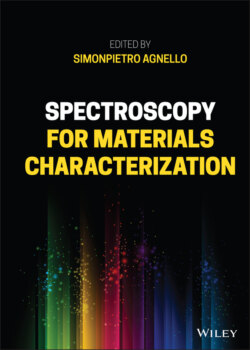Читать книгу Spectroscopy for Materials Characterization - Группа авторов - Страница 45
2.2.3.2 Time‐Resolved Detection System: Spectrograph and Intensified CCD Camera
ОглавлениеThe time‐resolved detection of luminescence spectra usually combines a Spectrograph and an Intensified CCD Camera. The light emitted by the sample enters a slit, whose width can be changed, then it is spectrally resolved by a spectrograph equipped with more gratings differing in the blaze wavelength, λ blaze, and in the spectral resolution depending on number of grooves per mm. Then, the luminescence light hits a photocathode, placed at the entrance of the Intensified CCD Camera, that releases electrons that are accelerated into the Micro‐Channel Plate (MCP). The MPC is an image intensifier consisting of a thin semiconductive glass plate, which is perforated by more than 106 small holes (channels) with a diameter in the range 10 ÷ 25 μm. Since the inner surface has a high secondary emission coefficient, the electrons that hit the channel walls generate additional electrons with a gain depending on the voltage at the MCP output. The electrons are further accelerated by a high voltage (5 ÷ 8 kV) and strike the phosphor coating on the fluorescent screen causing it to release photons. These photons are transferred to the surface of CCD, by optical fibers and produce charges at the pixels they strike. These charges, which are proportional to the number of incident photons, are then converted to an analog voltage, that is input to a A/D converter where it is digitally encoded and transmitted to the interface of the computer. Therefore, due to the MCP gain, for each photon that strikes the photocathode surface, many photons (>103) are produced. Moreover, the possibility of varying the photocathode voltage allows to enable or to disable the CCD: in the Gate ON mode, the photocathode voltage is usually set at −200 V and the CCD sees the light; in the Gate OFF mode, the photocathode voltage is zero and the CCD does not see the light.
As shown in the diagram of Figure 2.5, the Gate Width Δt determines the amplitude of the time window during which the CCD is enabled to reveal the luminescence light (Gate ON mode); while the Gate Delay T D regulates the temporal shift of the acquisition window with respect to the trigger signal (that is the arrival of the laser pulse). This setup allows the detection of time‐resolved luminescence spectra synchronized with the laser excitation pulses. The measured PL intensity is the light emitted from the sample, given by Eq. (2.65), integrated from T D to T D + Δt, in agreement with:
Figure 2.5 Diagram of the CCD timing: Gate ON and Gate OFF modes.
(2.76)
To acquire the decay curve, from which the lifetime τ can be estimated, it is necessary to acquire a set of PL spectra with a fixed Δt and T D ranging from zero to several τ, when the luminescence signal is extinguished. In fact, if (Δt ≪ τ), the integral in (2.76) reduces to:
(2.77)
that well describes the luminescence decay on increasing T D.
